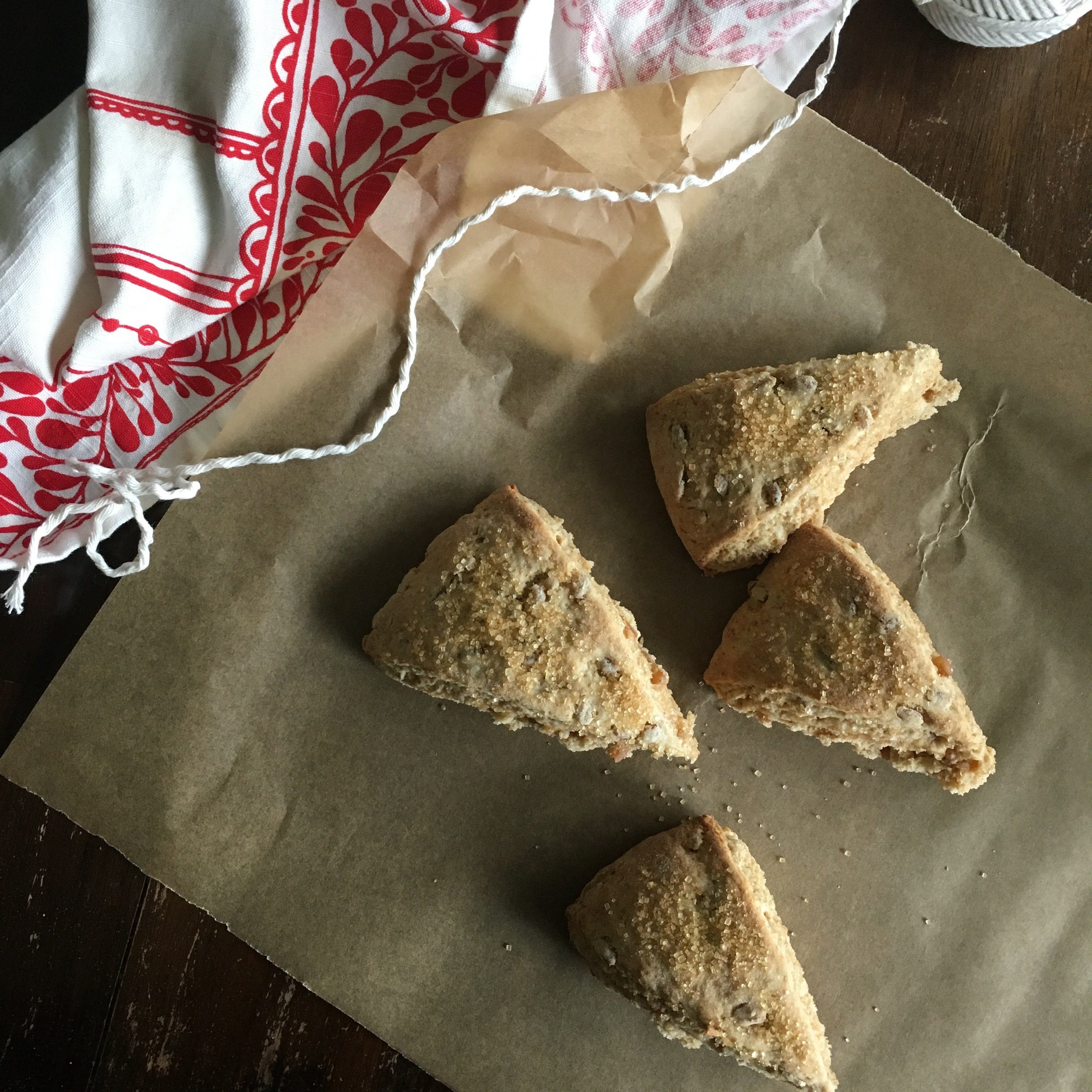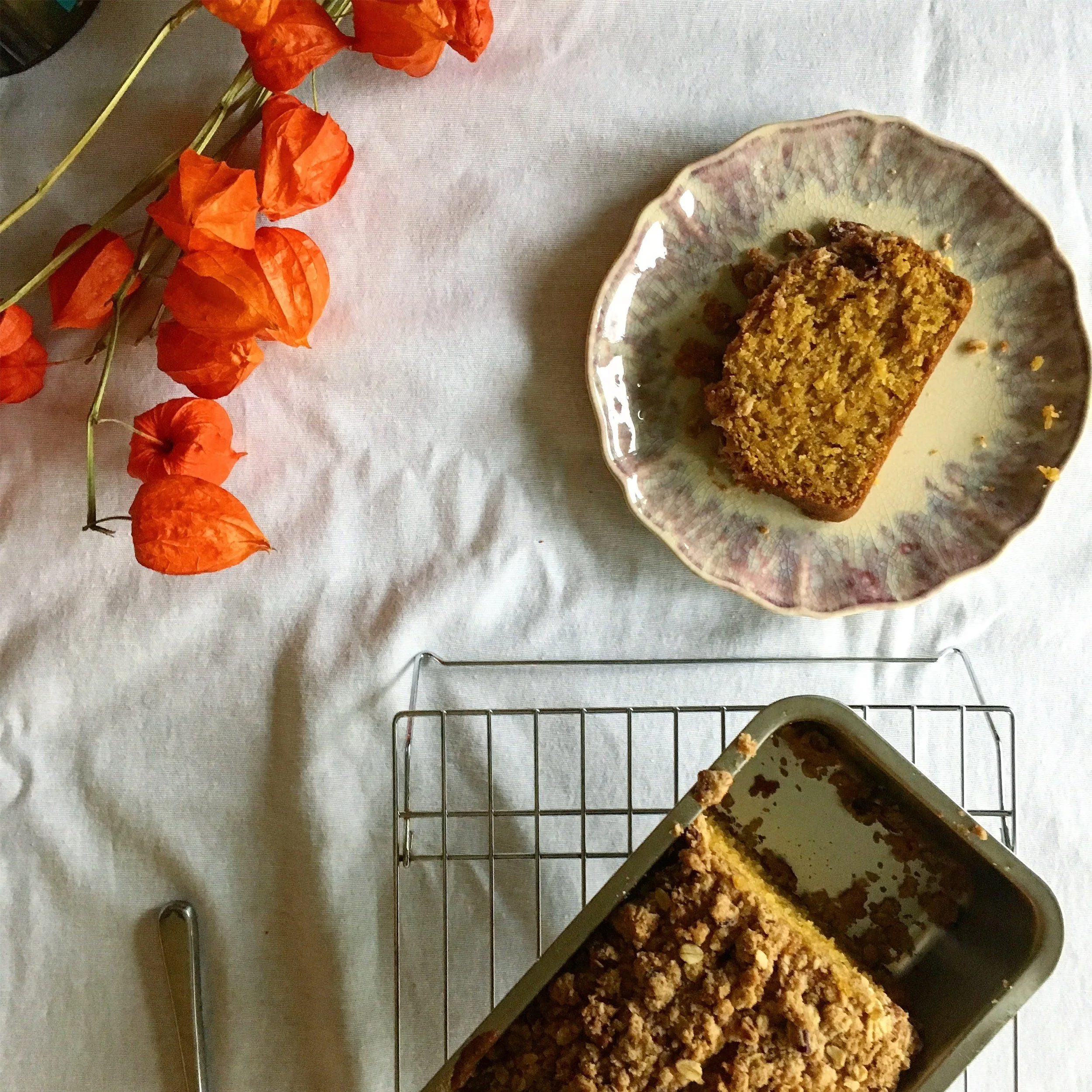Maple Farro Scones

A few weeks ago, around the time of the inauguration and subsequent Women's March, I had been reading Tamar Adler's An Everlasting Meal. It was one of those books that was so good, so comforting, so educational and reassuring that I stalled to finish it. I didn't want it to end. (It was also a lovely escape from the seemingly unending flood of bad/weird news each night.)
Adler's main thrust is that cooking should be an "everlasting" flow. Not quite simply leftovers, less of a production than double batches and freezer stockpiles, Adler encourages us to save the scraps from one meal -- or even one process, like roasting a chicken or cooking polenta or forgetting about celery -- to, well, feed a future meal, or more often, meals plural.
None of this is rocket science. All of it is what we mean to do in the kitchen someday: use vegetable trimmings and meat or fish bones for stock; cook or at least clean, chop, and store all of our vegetables for the week on a Sunday; make a big dreamy pot of beans that need only be slicked with olive oil and showered with parmesan for a supper fit for a peasant or a queen; find a local baker for good bread so you can eat any combination of those things on thick slices of garlic-rubbed toast and feel equally royal.
And yet: the book blew my mind. Maybe it's because every time I read about these tips in a magazine or on a food site, I get the same sneaking suspicion that I get about most food "tips and tricks" in this new viral world: there's a lot of writing about the living of one's best life on a Cheeto-smeared laptop in day-old yoga pants. Prescriptive writing, aspirational writing. Writing that convinces you you're doing it all wrong.
Adler's book, then, came into my life at the perfect time -- precisely the moment that I'm working on writing past all of that. She preaches not. Nary a whiff of moral exhortation. Just a lot of wonderfully boring-sounding ideas for how to use your bits & scraps. And a lot of wonderfully boring-sounding meals that I make all the time (aka Shit From My Fridge) that I've historically categorized as sellout meals, when I'm too tired to make the more ambitious, more virtuous, or more impressive thing I originally set out to make.
More importantly, no photos. An Everlasting Meal isn't a cookbook in the traditional sense: there are very few formal recipes. Just notes about stretching bean-soaking water embedded into a longer essay about, say, the thrumming potential of old celery or the harmonizing powers of olive oil. And yet: I haven't felt this inspired, this ready to cook, this grounded about cooking in a very, very long time.
Which is good, because I did a ton of cooking that week. I made two loaves of no-knead bread and two batches of scones -- one sweet, one savory.
Though we're a carb-loving household, I'm glad to say the baked goods went to a higher cause. A friend was hosting a little breakfast get-together before the Women's March in Chicago and I felt called to provide some sustenance to (literally) help feed the resistance.
The sweet scones were a triumphof pantry ingredients plus a surprising staple I like to keep around for salads: cooked farro. I had recently been infused with new energy by Adler's book for teeny-tiny tasks like cooking a little ol' batch of farro to have ready in the fridge. And when casting about for something to give the scones some texture and dial down the sweetness, I thought of this old NYTimes recipe for a half whole-wheat scone that calls for either walnuts or cooked wheat berries and subbed in the last scraps of farro instead.
These sustained a lot of people through what ended up being a much more substantial march than we anticipated (in the best way! -- 50k marchers expected; 250k was the actual number!). That said, these will just as handily get you through a harried weekday morning or weekend hike.
Notes:
The original recipe instructs you to bake these together in a round, then gently separate after they've cooled a bit. I found this to be an unusual and ultimately unnecessary move -- a few of my scones crumbled during that part of the process (though I was super mega gentle!). The dough is not so wet that you can't cut these into wedges before baking, and I'll wager it would result in a more even bake.
Maple Farro Scones
adapted from the New York Times
Ingredients
1 cup whole wheat flour
1 cup white flour (plus more for dusting)
2 tablespoons brown sugar, packed
2 teaspoons baking powder
1/2 teaspoon salt
1 stick chilled butter, cut into small cubes
1/2 cup cooked farro (or wheat berries, or even barley)
1/3 cup maple syrup
1 large egg
2 tablespoons milk
2 tablespoons raw turbinado (large-grain) sugar, for sprinkling (optional)
nonstick spray for baking sheet
Method
Set oven to 400F and spray baking sheet with nonstick spray.
In a large bowl, combine both flours, brown sugar, baking powder, and salt. Add butter and cut in using a fork, pastry blender, or, seriously, your hands until the mixture looks like fine crumbs.
Add the farro, maple syrup, egg, and milk. Stir to thoroughly combine -- the dough should leave the sides of the bowl and form a ball.
Turn out the dough onto a floured surface, sprinkling flour on top as well. Knead lightly, adding a bit more flour if the dough is very sticky. Shape the dough into a disk that's about 8 inches across, then cut into 8 wedges with a bench scraper or knife. Sprinkle the big sugar on top of the scones, if you like (it adds a nice crunch, I think).
Carefully place the wedges on the baking sheet. Bake until golden brown, about 20 minutes. These keep quite nicely but of course are gorgeous when served warm, with some butter or additional syrup.
Recipe Archive
- FYI
- appetizers
- baked goods
- basics
- beans + legumes
- booze
- bread
- breakfast
- brunch
- cheese
- chicken
- condiments
- dessert
- dinner
- dinner party
- drinks
- eggs
- fall
- fish
- freezer friendly
- fruit
- gluten free
- grains
- greens
- local
- lunch
- make ahead
- meat
- motherhood
- nuts
- pantry
- pasta
- pregnant food
- raw
- reading
- roasted stuff
- salad
- seafood
- sides
- snacks
- soup
- special occasions
- spring
- summer
- sweet
- tacos
- travels
- vegan
- vegetables
- vegetarian
Follow Book + Salt on Instagram













